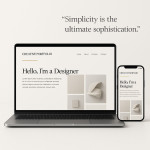Balancing personal experiments and client pieces in a portfolio update
A refreshed portfolio must prove commercial reliability and creative evolution. Learn how to mix personal experiments with commissioned work so that recruiters see the full extent of your talent in one scroll.
Why the balance matters for your next portfolio refresh
Recruiters skim a creative portfolio in under a minute. If they only find paid gigs, they may struggle to judge your current artistic curiosity. If they only find personal art, they fear you lack real-world problem-solving skills. A strategic blend communicates both.
Signals recruiters look for
- Commercial proof – budget respect, deadlines met, brand guidelines mastered.
- Originality – self-initiated pieces that test tools, formats or narratives.
- Growth trajectory – a clear line from experiment to paid deliverable.
The 60-30-10 framework: quick maths for a compelling mix
After auditing more than 300 high-performing creative portfolios, hiring managers repeatedly recommended a simple ratio:
| Category | Suggested share | Key objective |
|---|---|---|
| Client pieces | 60 % | Show reliability and industry fit |
| Personal experiments | 30 % | Display range, risk-taking and style research |
| Collaborative/side projects | 10 % | Highlight teamwork and cross-disciplinary agility |
This split keeps the focus on revenue-driving competencies while still letting your newest ideas sparkle.
Step-by-step workflow to curate both sides
1. Audit existing content
- Create two folders: “Client” and “Personal”. Drag every project file, mock-up or photo into the correct folder.
- Delete duplicates, outdated styles and anything that no longer represents your level.
- Score each remaining item on visual impact and storytelling potential. Keep only the top 40 from each pile.
2. Map experiments to briefs
Recruiters love to see how a wild trial became an invoice-worthy solution. Pair a personal prototype with the paid project it inspired and present them as a mini case study. For layout ideas, study the examples in this guide to case-study versus gallery formats.
3. Write concise captions
- Role – what exactly you contributed.
- Challenge – one sentence on the brief or self-set constraint.
- Outcome – metric, quote or lesson learned.
Avoid fluffy adjectives; focus on facts recruiters can re-tell during internal meetings.
4. Optimise loading speed
High-resolution experiments often mean heavy files. Compress images and lazy-load videos so visitors never wait. Techniques inside this optimisation checklist shave seconds off every page view.
5. Sequence for narrative flow
Start with a striking personal experiment, follow with two client pieces, repeat. This pattern keeps curiosity high and underlines cause-and-effect learning. For more visual sequencing ideas, explore visual storytelling tweaks.
Common pitfalls and how to dodge them
- Over - editing – deleting too many client projects can make you look inexperienced.
- Under-crediting collaborators – always list partners; anonymity raises red flags.
- Ignoring accessibility – alt text for images, captions for motion; compliance widens reach.
Boost discoverability while you update
Publish an “update in progress” banner with a subscribe form. Early traffic signals keep your SEO steady during revamp work. Follow the entire pre-launch checklist in this 2025 portfolio checklist.
Pro tip: cross-post one hero experiment on Artfolio's new-portfolio spotlight to funnel curious art buyers straight to your refreshed site.
Mini case study: turning a personal test into a paid campaign

Illustrator Maya Rivera created a weekend series of animated GIF stickers exploring neon gradients. She posted them on Instagram Stories, tagged her colour palette and explained the process in her captions. Three weeks later, a snack brand's agency asked for a 10-sticker pack for a TikTok launch. Rivera earned €4 800 and now frames the two projects side by side in her portfolio, proving how experimentation drives revenue.
Ready to test yourself?
FAQ
- Do unpaid personal projects scare professional clients?
- No. When clearly labelled, they demonstrate initiative and skill exploration without suggesting you work for free.
- How often should I swap personal pieces in or out?
- Quarterly reviews keep experiments fresh without harming SEO continuity.
- Can I include speculative redesigns of big brands?
- Yes, if you mark them “Concept” and avoid trademark misuse. Focus on process, not the logo.
- What if client NDAs block me from showing the work?
- Blur sensitive data, present mock-ups, or write a text-only case study emphasising outcomes.
- Is 60-30-10 universal?
- No, it's a guideline. Adjust to industry norms: motion designers might push experiments to 40 % to showcase technique variety.
Conclusion: curate, don't cram
A portfolio update is less about adding files and more about crafting a story. Keep the 60-30-10 rule in mind, pair experiments with outcomes, and optimise speed plus accessibility. Do that, and your next recruiter will reach out before they hit the footer.
Ready to apply these tips? Block two focused afternoons this week to audit, pair and caption. The results will echo in your inbox for months.











